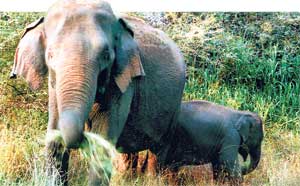
Chasing elephants is not the answerWasgamuwa: Poor development planning and resultant human-elephant conflict The Daily Mirror of November 20, 2007 reported that the residents of the Minipe area, protested outside the Wilgomuva Divisional Secretariat, demanding an immediate solution to the threat posed by wild elephants. The consensus among the authorities from Minister Janaka Bandara Tennekoon, Chairman of the Matale Coordinating Committee, to ministers of the Central Province, the Divisional Secretary and officers of the Department of Wildlife Conservation, as stated in the report is that a solution should be found to rid the area of the ‘elephant menace’. Chasing the elephants seems to be the most appealing idea and the Wildlife Department’s lack of resources seems to be the stumbling block! Where the elephants are to be chased is not clear. Are they to be chased into an area strictly demarcated for wildlife? Is there an assumption that, with no buffer zone to allow for animals to stray without stumbling on humans and their property, elephants will recognise the line that has been drawn on paper dividing human habitat from wildlife habitat? Are we to assume that all our problems will be solved when the 660 km of electric fence around Wasgamuwa National Park is complete in 11years (by the Wildlife Conservation Department’s estimate) and that then, the remaining elephants will strictly abide by the rules without attempting to push the fence down each night?
Is it possible that the recent destruction of the Elahera Elephant Corridor and the western buffer zone of Wasgamuwa National Park for the proposed construction of the Moragahakanda Reservoir and the land cleared in the Maduru Oya –Wasgamuwa Corridor for a mega, private poultry farm have brought the human-elephant conflict of this region to a head? To me, the assumptions and efforts of the authorities seem incredibly short-sighted. Politicians in their desperate scramble for votes repeatedly present land deeds adjoining elephant habitat. The recipients, poor farming families, battle elephants each night to protect their crops; as no alternative means of income have been introduced, both humans and elephants lose their lives each year. By then, the once benevolent politician is out of reach and both man and beast are trapped in a vicious cycle. Government officials, as desperate as the politicians to move up the professional ladder, produce development plans that pander to politicians rather than viable solutions for their country and its people. The recent revival of long abandoned plans for Moragahakanda Reservoir in the Matale District is a showcase for the greed and indifference of politicians and government officials alike. Exceeding both Minneriya and Kala Weva reservoirs in size, Moragahakanda Reservoir is a disaster waiting to happen! The primary environmental hazard is the danger of contamination of water bodies in the vicinity due to drilling and inundation of a limestone bed of this proportion. Designed to provide drinking water to Anuradhapura, Polonnaruwa and Trincomalee, the tragedy will be if its construction destroys the potable water sources of Matale! Besides the dire threat of water contamination, the incalculable effects of a heightened human-elephant conflict are obviously surfacing already. This massive project, with an outdated, superficial Environmental Impact Assessment (EIA), was inaugurated last March with a highly politicised ceremony, smack in the middle of the Elahera Elephant Corridor. Construction of workers, housing, offices and roads for the project has disrupted forest life. According to the project proposal, an alternate elephant corridor will be provided north of Elahera town, but no steps have been taken in this highly populated area. In addition, 400 hectares on the western boundary of Wasgamuwa National Park, claimed for resettlement of people displaced by Moragahakanda, is being deforested and burnt in anticipation of the new settlers. Today, the world over, development is being designed to be sustainable; the leading nations of the world struggle to reverse their follies, amend their laws to create larger lungs for a planet that is suffocating and treasure the endangered species of the world. Seemingly unaware of the global trend, Ivan Silva, Director General of the Mahaweli Authority, displays his level of concern for the country’s natural environment by stating that, “the land proposed for resettlement (400ha of Wasgamuwa National Park) in fact belongs to the Mahaweli… (it was) released for the wildlife and now we are simply reclaiming it.” An invaluable natural resource of a nation is ‘reclaimed’ by a transient government official! In the interest of man and elephant thrown into conflict by poorly designed development plans, perhaps some intelligent revisions could be attempted. Introduction of conservation generated alternate income schemes to supplement dry season agricultural practices and reclamation of buffer zones for wildlife through suitable land utilization incentives would certainly ease the pressure. Sri Lanka could still catch up with the rest of the world in its plans for development, if progressive policies such as that of the European Union are adopted and a precondition of sustainability is applied. Failure to redefine the character of development will confirm a future where, our children will have to look at wild elephants lined up along the fence lines of shrunken, Auschwitz style, enclosures; villagers who protest at Wilgomuva today, having long abandoned cultivation on their denuded lands, would have moved to grotty, unplanned townships and the names of contented politicians and government officials would be long forgotten… but what of our country? Known for aeons as the fertile beauty of the Indian Ocean that was home to the greatest elephants…. |
|| Front
Page | News | Editorial | Columns | Sports | Plus | Financial
Times | International | Mirror | TV
Times | Funday
Times || |
| |
Reproduction of articles permitted when used without any alterations to contents and the source. |
© Copyright
2008 | Wijeya
Newspapers Ltd.Colombo. Sri Lanka. All Rights Reserved. |
